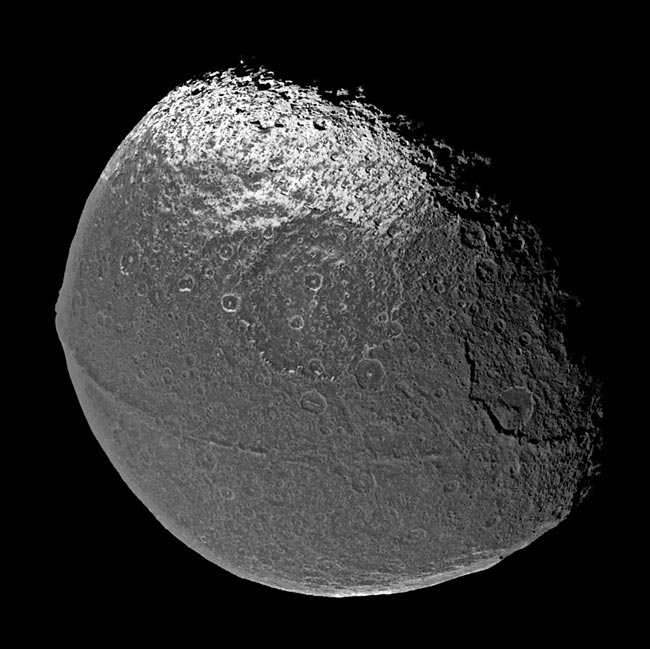Walnut-Shaped Moon's Mystery Solved

There's astrange moon whizzing around Saturn that's shaped, oddly, like a walnut.
Nowastronomers find that Iapetus got its nutty shape from a super-fast spin that wasfrozen into place early in the solar system's formation.
When theCassini spacecraft snapped close-upsof Saturn's moons in 2005, it revealed a bulging waistline of rock along theequator of the now slowly spinning Iapetus. Astronomers think thischaracteristic shape persists because Iapetus was cryogenically frozen in timeabout 3 billion years ago, during the moon's "teen" years.
"Iapetusspun fast, froze young and left behind a body with lasting curves," saidJulie Castillo, a Cassini scientist at NASA's Jet Propulsion Laboratory (JPL)in Pasadena, Calif.
Unlike anyother moon in the solar system, Iapetus (eye-APP-eh-tuss) has retained itsimmature figure. Running exactly along its midsection, a chain of mountains 808miles (1,300 kilometers) long and 12 miles (19 kilometers) high adds to themoon's walnut-likeappearance.
"Youwould expect a very fast-spinning moon to have this bulge but not aslow-spinning moon, because the bulge would have been much flatter," saidDennis Matson, another Cassini project scientist at JPL. However, Mason said,"we've modeled how Iapetus formed its big, spin-generated bulge and whyits rotation slowed down to its present, nearly 80-day period."
Iapetusoriginally spun once every five to 16 hours, which was fast enough to buckleits surface at the equator, according to the new model detailed in an upcomingonline edition of the journal Icarus.
Get the Space.com Newsletter
Breaking space news, the latest updates on rocket launches, skywatching events and more!
Scientiststhink radioactive elements heated the moon's interior to permit the crust tostretch and buckle, yet quickly froze the moon into shape as fuel ran out.
"Iapetus'development literally stopped in its tracks," Castillo said of the 4.564billion-year-old hunk of rock. In order to slow the young moon down its presentonce-per-80-days rotational speed, Castillo explained, "its interior hadto be much warmer, close to the melting point for water ice."
The findingshould help astronomers better understand how the planets and their moonsystems formed in the early solar system.
"Thisis the first direct evidence of the early spin history for a satellite in theouter solar system," Matson said. "It ? broadens our knowledge of theearly history of outer planet satellites."
- The Strangest Things in Space
- Gallery: Cassini's Latest Discoveries
- Video: Cassini's Crossing
Join our Space Forums to keep talking space on the latest missions, night sky and more! And if you have a news tip, correction or comment, let us know at: community@space.com.
Dave Mosher is currently a public relations executive at AST SpaceMobile, which aims to bring mobile broadband internet access to the half of humanity that currently lacks it. Before joining AST SpaceMobile, he was a senior correspondent at Insider and the online director at Popular Science. He has written for several news outlets in addition to Live Science and Space.com, including: Wired.com, National Geographic News, Scientific American, Simons Foundation and Discover Magazine.









